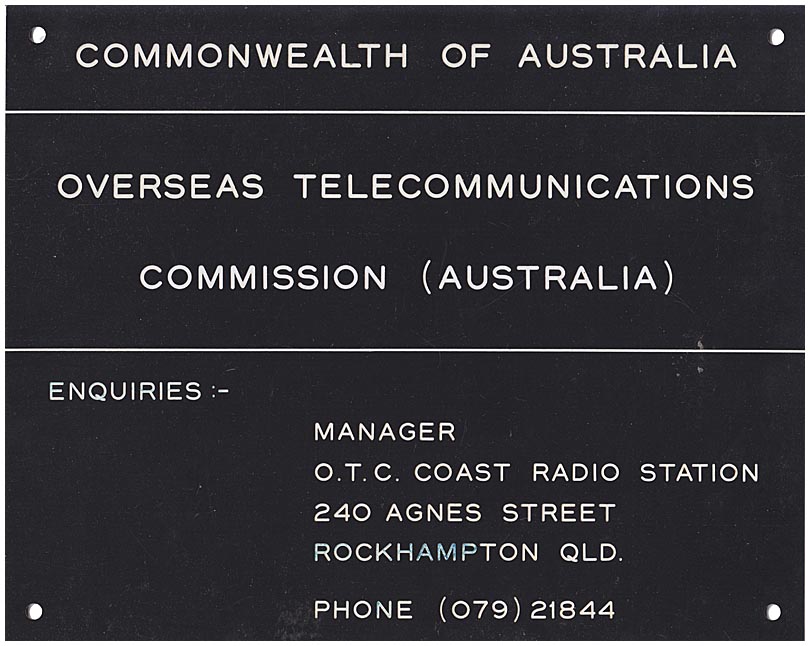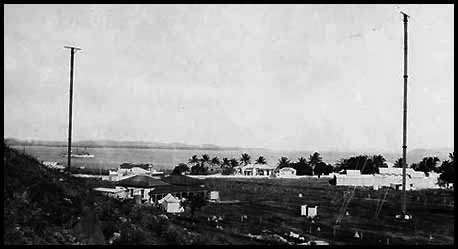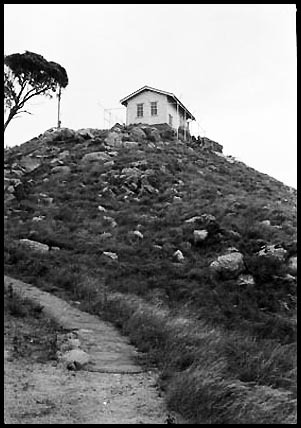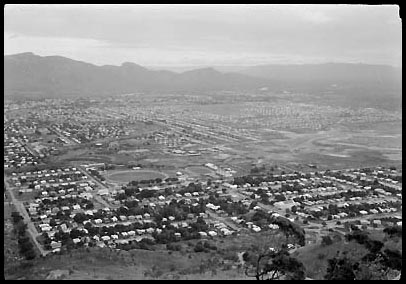Coastal Wireless Stations - Queensland.
- Australia 1901-1988
- New South Wales
- Queensland
- South Australia
- Tasmania
- Victoria
- Western Australia
- International
- Special aspects
There were five Coastal Radio Stations operating in Queensland:
| Call sign: VIB | |
| Opened: 2 September 1912. | Closed: |
| Location: Pikenba about 13 kms from Brisbane. The air was cooler than in Brisbane being closer to the mouth of he Brisbane River. | |
| Transferred to: | |
Brisbane was always a continuous watch station for shipping. It also communicated with several lighthouses in the region.
In May 1912, the Minister for Home Affairs announced that the State Public Works Department for Queensland had been approved to erect an engine house, accumulator room and operator house on the site of the proposed Brisbane radio-telegraph station near Pinkenba.
| Call sign: VIM | |
| Opened: 12 June 1913. | Closed: Soon after control transferred to OTC in 1947. |
| Location: On top of a 200 metre hill (referred to as "Old Grassy) - much to the chargrin of the staff. | |
| Transferred to: Townsville took over responsibility for communications from New Guinea in 1930 leaving Cooktown with the responsibility for ship traffic. | |
It was reported on 27 September 1912 that Senator Findley, in reply to Senator Sayers (Q ), had said that a site had been selected for a wireless telegraph station at Cooktown, and the equipment ordered for this station would be opened in April.
In the Cairns Post of 19 June 1920, under the heading SOME OF THE ATTRACTIONS OF COOKTOWN VICINITY is listed:
"Grassy Hill Signal Station and Cooktown Radio Station overlook the town, about 20 minutes' climb from the main street".
When the landline up to Cape York was broken, Cooktown would exchange telegraphic messages with Thursday Island.
An interesting misunderstanding of the nature of land lines versus radio surfaced at a meeting of the Cairns Chamber of Commerce and was reported in the Cairns Post on 28 March 1914: "The Townsville Chamber of Commerce wrote stating they had written to the Federal Government supporting the request of the Cairns Chamber for a wireless station.
On the same subject, Mr. Bamford forwarded a letter received by him from the Postmaster-General's Department: The letter stated that interruptions to the land telegraph lines had been caused in the past by bush fires and cyclonic disturbances over which the Department had no control. There were various parties of linemen working in the north and every effort was made, as soon as a break occurred, to restore communication as speedily as possible.
The same Department has advised that Cairns participated in the radio telegraphic service at Cooktown, and the expense involved in establishing such a station at Cairns was therefore not warranted. The normal range of the Cooktown station was 500 miles over the sea and 200 miles on land.
Mr. A. J. Draper said he failed to see now Cairns benefited from the radio station at Cooktown, when there was no wireless station here to receive or transmit messages.
The President said there was a further letter from Mr. Bamford, M.H.R. in which the writer stated he personally could not see how Cairns participated in the benefits of the Cooktown radio station.
Mr. Draper: I will move that we write and ask the Department to enlighten us as to the manner in which we are benefiting from the station at Cooktown.
Mr. P. Doyle seconded the motion.
Mr. Draper : In writing it would be advisable to point out that at critical periods of the year, we have no communication with Cooktown through the land lines being blown down".
A reply from the Government was forthcoming and reported in the Cairns Post on 17 April 1916 and on 1 August 1921.
An insight into the operation of the Coastal Radio Stations is given by the following note in the Cairns Post of 29 May 1931:
"Mr. Stewart Hamilton, who has just concluded his triennial term of Tropical Service with the Amalgamated Wireless at the Cooktown Radio arrived in Cairns by the Merinda yesterday afternoon en route to Sydney on transfer. Mr. and Mrs. Hamilton are naturally pleased to be going to their Southern friends again but Mr. Hamilton admits that there is a wrench after all in leaving the Far North which has many charms. Mr. West has succeeded Mr. Hamilton at Cooktown".
| Call sign: VIR | |
| Opened: 24 May 1913. | Closed:. |
| Location: 45 kms up-river. | |
| Transferred to: OTC on 1February 1947. | |
Main responsibility was to maintain contact with larger vessels although was well-known for its significant involvement with outlying communities, cattle stations and missions.
A series of interesting advertisements were placed in the Rockhampton Morning Bulletin in 1924-25 for A. B. Menzies Prescription and Toilet Chemist located in East Street Rockhampton. In addition to Menzies' "Mister Skeeter" Lotion to ward of mosquitos and Nyal's Face Cream, the advertisements ended with either "Radio and Wireless parts stocked" or "Radio and Wireless Parts: Fresh stocks Weekly".
In October 1928, the Steamer Kinross ran aground 260 miles off Rockhampton and had to radio to VIR for assistance.
Technical details about the station's equipment can be obtained elsewhere.
 Sign from the door of the Rockhampton O.T.C. Coast Radio Station. |
| Call sign: VII | |
| Opened: 26 February 1913. | Closed: 1 February 1992. |
| Location: 25 kms north-west of Cape York peninsula. The island is about 4 square kilometres in size. The main town is Port Kennedy. | |
 Thursday Island looking towards the Radio Station C. 1920. Source: State Library of Queensland # 515298. |
| Call sign: VIT | |
| Opened: 7 August 1913. | Closed: . |
| Location: On top of a hill . | |
In 1931, Townsville replaced Cooktown as the main relay station for messages from New Guinea to Sydney.
 |
Left: Townsville Radio wireless station on Castle Hill. Source: NLA J2364 1602 2 & 4. |
Footnote:
A note in the Perth Sunday Times of 2 May 1926 describes the activities of Mr. G. A. Scott, the then local Commonwealth Radio Inspector who had had an adventurous career in the realms of wireless. "... From 1901 to 1908, he had thorough naval training in wireless and in the latter year he came to Australia. From then on his career has been meteoric-1911 to 1912 saw him in the service of Father Shaw, the well-known scientist. His experiences here ranged from New Guinea to Tasmania. His appointment to radio telegraphist at Melbourne came in March of 1912 (Note: one month after opening) and in June of the same year he was entrusted with the erection of the Brisbane station. On completion of this, he was in charge of the construction of Rockhampton radio. Both these jobs called for outstanding ability, engineering practice and practical experience, and it is worthy of note that Mr. Scott was selected for this duty by the then PMG engineer for radio telegraphy Mr. J. G. Balsillie. July, 1918 saw him transferred to Western Australia as radio inspector - first located at Fremantle and then at the G.P.O., Perth".
